calsfoundation@cals.org
The CALS David Stricklin Research Fellowship Experience: Lisa C. Childs, 2023
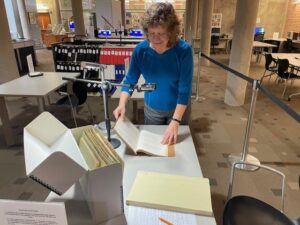 I’m just starting to recover from the three busy days I spent in the Research Room of the CALS Bobby L. Roberts Library of Arkansas History & Art late last year.
I’m just starting to recover from the three busy days I spent in the Research Room of the CALS Bobby L. Roberts Library of Arkansas History & Art late last year.
When I applied for the 2023 David Stricklin Fellowship, I listed about fifty collections that seemed likely to have something to do with my research topic: the Ouachita Mountains of western Arkansas (and eastern Oklahoma). I wanted to do my best to look at all of them as I work to expand my earlier research into a book-length history of the Ouachitas. And, with the help of some very friendly and organized archivists, I pretty well achieved my goal. I will say, however, that my days there felt like I was on the ’90s gameshow Supermarket Sweep, only I was trying to fill my phone with copies of documents instead of filling my grocery cart with hams.
The week before I was to arrive, Brian Robertson, who is manager of the Research Services Division of the CALS Butler Center for Arkansas Studies at the Roberts Library, emailed me to suggest that I identify which files I wanted pulled first, and, when I arrived Monday morning, there was a four-shelf rack, packed with about half the materials I’d identified. (The second half made its appearance on Tuesday.) I took a deep breath, laced up my sneakers, and began scooping items up and throwing them willy-nilly into the grocery cart—I mean: I handled the boxes and folders carefully, photographing the documents one by one and gently returning each one to its folder.
Some of the cool things I found, in roughly chronological order:
- Lorenzo Gibson’s 1847 ferry license for his place near Rockport (Hot Spring County) where the Military Road crossed the Ouachita River.
- Ellenwood Ballard’s December 17, 1863, letter to his Iowa cousin Elvira Harrison “from the wilderness” near Waldron (Scott County) made me glad I could turn up the thermostat a notch. He hadn’t “had a change of clothing for three weeks and it has been raining and sleeting a good share of the time. That is what we call rough soldiering down in this country.” Ballard was in the 2nd Kansas Cavalry (US), which enlisted a number of Ouachita men while they camped at Roseville and Waldron.
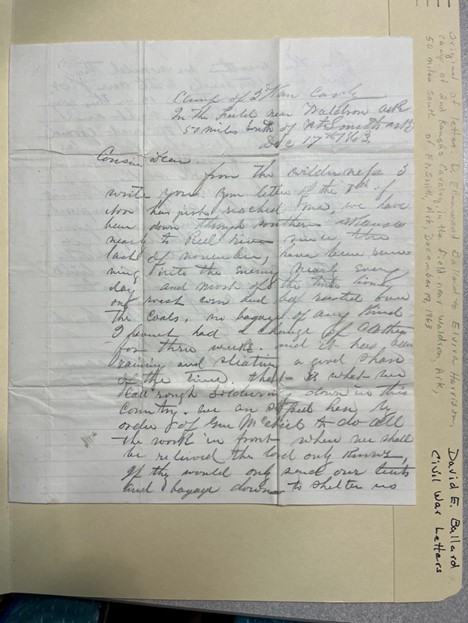
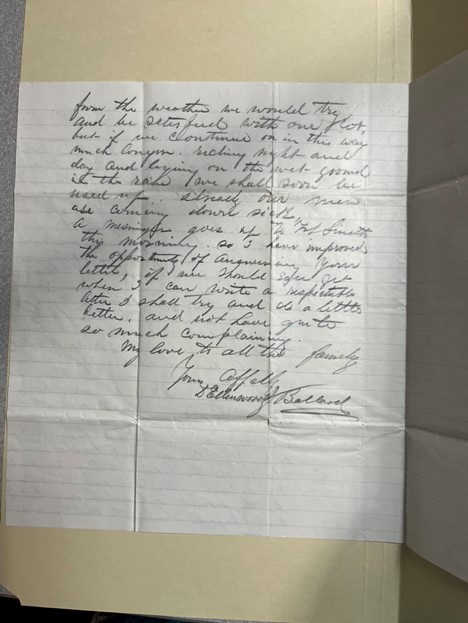
- Minutes for the Knights of Pythias in Hot Springs (a mutual aid society for white men). These minutes included an entry from March 7, 1878, where the lodge “did not open in due form” and Rev. A. W. Winfield’s offer of the local Methodist church was accepted due to the “late conflagration which happened on the 5th instant, which laid in ashes more than half of the business…of our beautiful valley together with our lodge room &c. and many of the brethren were reduced to penury and want.” This entry put Rev. Winfield (the namesake of Winfield Memorial United Methodist Church in Little Rock, a.k.a. Quapaw Quarter UMC) in the same space as the first of three disastrous fires in Hot Springs (there were others in 1905 and 1913). I always like being reminded just how small and connected Arkansas is and was.
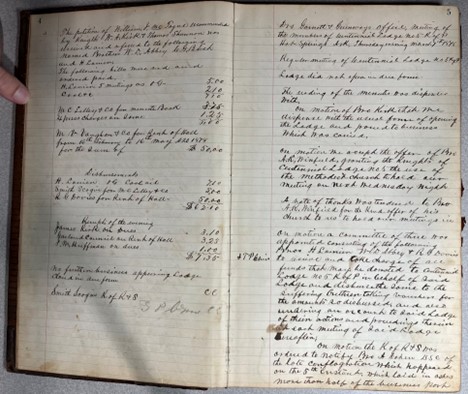
- A partial photocopy of Will Morris’s 1888 diary from Antimony City in Sevier County, where he describes his wife’s labor and delivery, concluding that “she did very well & did not have as hard a time as I anticipated, but the afterbirth was found to adhere to her side; this, together with hour glass contraction, caused her intense pain when the Doctor was compelled to take it from her….Both Della & the boy are doing very nicely. Still cloudy.”
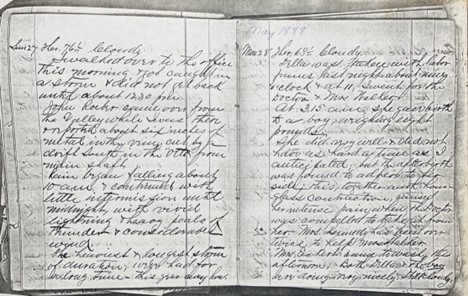
- Prints from lantern slides taken at the resort of Baker Springs in northern Howard County in about 1915, including young women preparing to swim.
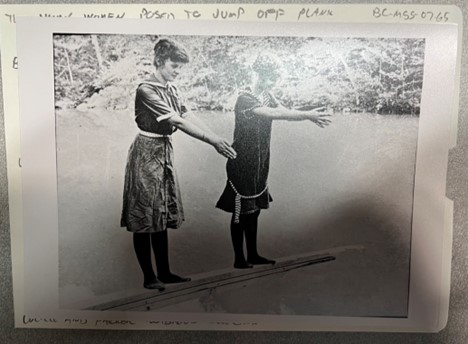
- Simon Marrs’s minutes for a 1913 meeting of the Grand Order of Odd Fellows (a mutual aid society for African Americans). Marrs was formerly enslaved, first owned by the Edmisten family in Washington County, then sold (probably as part of an estate sale) to the nearby Marrs family (where he was separated from his mother and two younger siblings, who were purchased by the Billingsley family). Simon and his brother Peter Marrs were moved to Crawford County. The brothers eventually ended up in Hot Springs (Garland County), where Simon worked as a carpenter and was an officer of the Grand Order of Odd Fellows. When he died in 1926, he left “the Large Picture of My self and aunt Kate [meaning his wife] and the picture of our Baby Boy” to his niece, who was also charged with being “the Custodian of the Family Bible.”
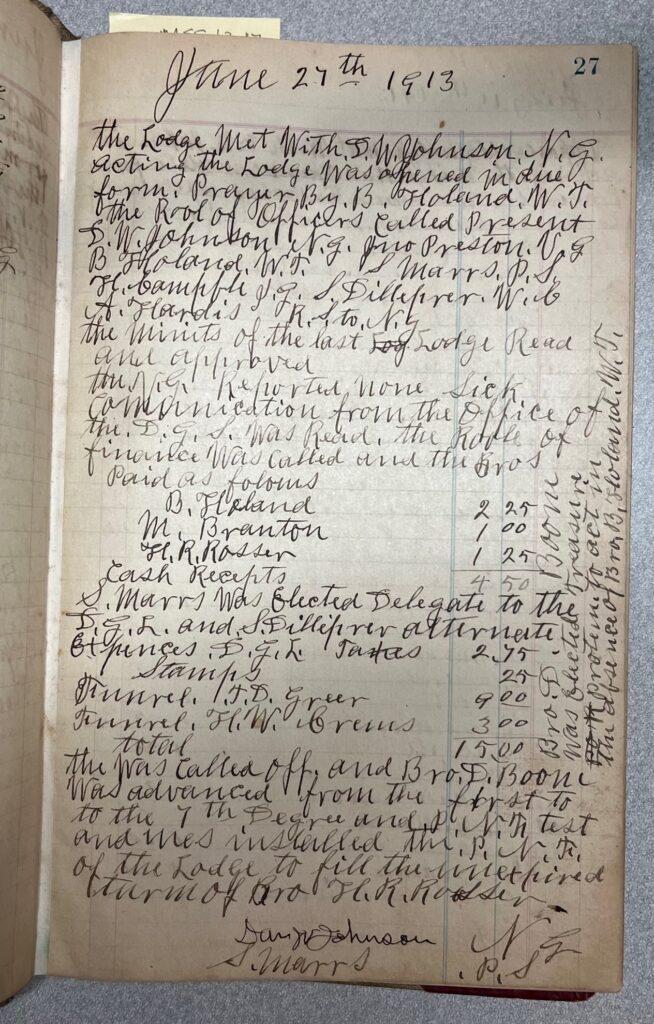
- A series of reports about the state of the elementary schools, general farming conditions, fruit and berry farming, coal mining, “unemployables,” and the like, compiled by the Civil Works Administration and the Federal Emergency Relief Administration (FERA) in the mid-1930s. These reports will help me understand how the Ouachitas fit into the state of Arkansas, and they come with some lovely maps.
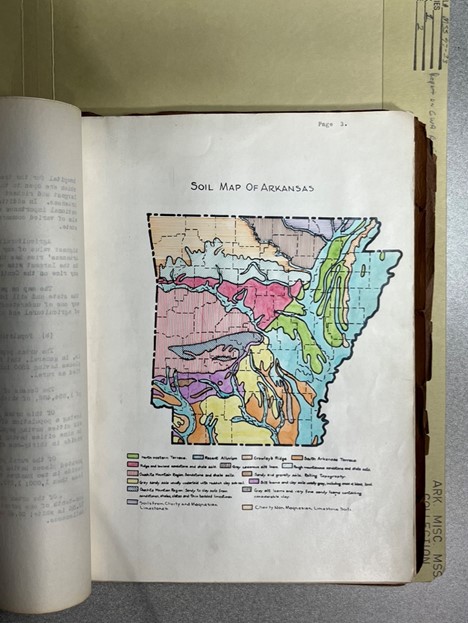
- Dozens of World War II letters from the Rector family (Polk County), including an August 1944 series where George Rector was practically frantic with worry since his wife was to have an appendectomy in Mena (Polk County) and he couldn’t get leave, nor could he even get roses to her since the closest florist he could have wire her flowers was in Fort Smith. (He sent her asters, hoping they wouldn’t wilt.)
- And although I expected the hams—I mean the big-money items—to be the Simon Marrs collection and the Civil War letters from Union soldiers stationed around Waldron, the file that touched my heart was Fla (née Page) Hill’s album. Fla first went to Arkansas State Tuberculosis Sanitorium in Booneville (Logan County) in October 1926. She probably spent the better part of four years there. She was a young married woman (or possibly recently widowed) when she arrived. Fla brought what seems to have been a trusty Brownie camera with her—and scrapbooked her way through her treatments. What I’ve loved showing people who ask about my research trip is a photo captioned “Lindy on Oct. 1, 1927” (the top photo on the scrapbook page). This photo showed aviator Charles A. Lindbergh flying over Booneville on his way to a massive celebration in Little Rock. It is a great reminder that people living in the Ouachita Mountains were aware of and connected to the rest of the world.
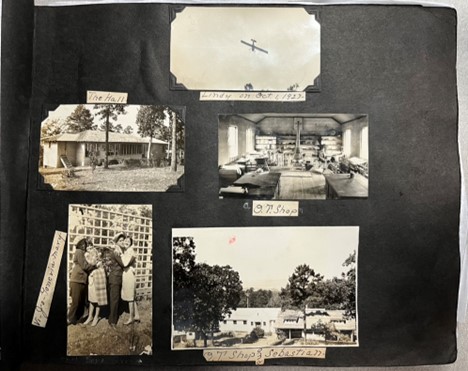
My rush through the archives was (thankfully) paused to have lunch on Tuesday with the folks who made it possible: Brian Robertson, Glenn Whaley (manager of the CALS Roberts Library), David Stricklin (former Butler Center director, for whom my fellowship is named), and Bobby L. Roberts (former CALS director and source of the Roberts Library’s name). I truly enjoyed getting to know them all better—and the lunch was so fun that we forgot to take pictures.
I left the Roberts Library with a great appreciation for both the archivists and the people who entrusted their documents to the archives of the Butler Center—as well as a tremendous number of documents for me to sort through and put to good use.
By 2023 Stricklin Research Fellow Lisa C. Childs, PhD, assistant vice president for technology commercialization, patent attorney, University of Arkansas System, Division of Agriculture
***
The David Stricklin Research Fellowship was established in honor of former CALS Butler Center for Arkansas Studies director David Stricklin to assist students, teachers, and other researchers in using materials held by the Butler Center. Learn more about it here.




